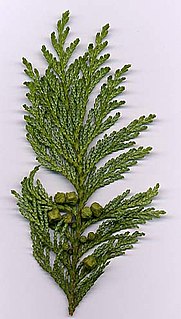Related Research Articles

Chamaecyparis, common names cypress or false cypress, is a genus of conifers in the cypress family Cupressaceae, native to eastern Asia and to the western and eastern margins of the United States. The name is derived from the Greek khamai (χαμαί), meaning "on the earth", and kuparissos (κυπάρισσος) for "cypress".
The Nematoceran family Axymyiidae is the sole member of the infraorder Axymyiomorpha, though it is often included within the infraorder Bibionomorpha in older classifications. It is known from only seven species in three genera, plus three fossil species.

Cordalia is an extant genus of aleocharine rove beetle in the tribe Falagriini. It was discovered by Jacobs.

The Glyphipterigidae are a family of small moths commonly known as sedge moths, as the larvae of many species feed on sedges and rushes. More than 500 species have been described in the family.

Pinus taiwanensis, the Taiwan red pine, is a species of conifer in the family Pinaceae. It is found only in Taiwan. It is a close relative of Pinus luchuensis of Japan and Pinus hwangshanensis of China, sometimes considered as a subspecies of the former. Sometimes Pinus hwangshanensis from China are also referred to as P. taiwanensis. Pinus taiwanensis var.fragilissima and P.taiwanensis var.taiwanensis are the two varieties of this species. Taiwan red pine is a large tree, with a straight trunk up to 35 m (115 ft) tall and 80 cm (2.6 ft) in diameter. Needles are in bundles of two. Cones are 6–7 cm (2.4–2.8 in) long. It is a common species in the Central Mountain Range at altitudes of 750–3,000 m (2,500–9,800 ft), often in pure stands.

Chamaecyparis taiwanensis is a species of cypress, native to the mountains of Taiwan, where it grows at altitudes of 1300–2800 m.

Leucoblepsis is a genus of moths belonging to the subfamily Drepaninae. The genus was erected by William Warren in 1922.
Myotis taiwanensis is a species of mouse-eared bat. It was for some time considered to be a subspecies of Myotis adversus.

The garden eels are the subfamily Heterochongrinae in the conger eel family Congridae. The majority of garden eels live in the Indo-Pacific, but species are also found in warmer parts of the Atlantic Ocean and East Pacific. These small eels live in burrows on the sea floor and get their name from their practice of poking their heads from their burrows while most of their bodies remain hidden. Since they tend to live in groups, the many eel heads "growing" from the sea floor resemble the plants in a garden. They vary greatly in colour depending on the exact species involved. The largest species reaches about 120 cm (47 in) in length, but most species do not surpass 60 cm (24 in). Garden eel colonies can grow as large as one acre in surface area.

Dysomma is a genus of eels in the cutthroat eel family Synaphobranchidae.

Spilosoma sagittifera is a species of moth of the family Erebidae. It was described by Frederic Moore in 1888. It is found in India, Nepal, China and Taiwan.
Carmentina is a genus of sedge moths.
Carmentina chrysosema is a species of sedge moths in the genus Carmentina. It was described by Edward Meyrick in 1933. It is found on the Solomon Islands.
Carmentina polychrysa is a species of sedge moths in the genus Carmentina. It was described by Edward Meyrick in 1934. It is found on Java.
Carmentina pyristacta is a species of sedge moths in the genus Carmentina. It was described by Turner in 1913. It is found in Australia, including Queensland.

Cybocephalus is a genus of beetles in the family Cybocephalidae, previously belonging to the subfamily Cybocephalinae of the family Nitidulidae.

The sharp-nose garden eel is an eel in the family Congridae. It was described by Shao Kwang-Tsao in 1990. It is a marine, subtropical eel which is known from Taiwan and southern Japan, in the northwestern Pacific Ocean. It is non-migratory, and dwells at a depth range of 14 to 22 metres. Males can reach a maximum total length of 74.1 centimetres (29.2 in). It can be identified by the shape of its snout.
Cupriavidus taiwanensis is a Gram-negative, nitrogen-fixing bacterium of the genus Cupriavidus and family Burkholderiaceae, which forms indeterminate nodules on Mimosa pudica. The genome of C. taiwanensis is completely sequenced.
Acanthopagrus taiwanensis is a fish native the waters around Taiwan. It was described in 2006, when it was recognised as distinct from Acanthopagrus berda.

Sacodes is a genus of marsh beetles in the family Scirtidae. There are about seven described species in Sacodes.
References
- ↑ Beccaloni, G.; Scoble, M.; Kitching, I.; Simonsen, T.; Robinson, G.; Pitkin, B.; Hine, A.; Lyal, C., eds. (2003). "Carmentina taiwanensis". The Global Lepidoptera Names Index . Natural History Museum . Retrieved April 28, 2018.